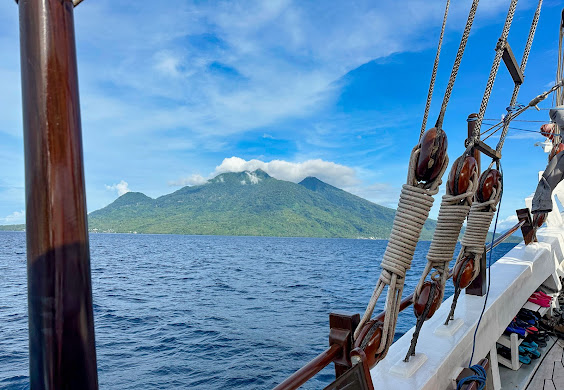When I was writing the previous article on the Crested Macaques (Macaca nigra) of the island of Bacan in the Moluccas, I came across an anomaly in the records. A paper* mentions the early records of the presence of monkeys on Bacan by referring to a publication written in 1969 by Jack Fooden of the Field Museum in Chicago on the taxonomy and evolution of the monkeys of the Celebes (Sulawesi). There the earliest report of the monkeys on Bacan is attributed to the book by Quoy and Gaimard which was published in Paris in 1830. Jean René Constant Quoy (1790-1869) and Joseph Paul Gaimard (1793-1858) were the surgeon/naturalists on the expedition of 1826-29 led by Jules Sébastien César Dumont d'Urville (1790–1842) on board the French corvette, Astrolabe. Accounts of the expedition were published in a series of volumes between 1830 and 1834.
I found the anomaly while looking at the original volume by Quoy and Gaimard which is available online. The male Crested Macaque they described was not shown as having been collected on the island of Bacan, then known as Batchian, but of Matchian, now Makian, a small volcanic island 90 km or 60 miles to the north of Bacan.
 |
| Makian, the island where Quoy & Gaimard stated they had obtained their monkey Photographed from the south-east from the deck of the yacht—a converted phinisi—Katharina 29 November 2022 |
This is what Quoy and Gaimard wrote:
Il habite quelques-unes des iles Moluques. Celui-ci provenait de Matchian. Son âge pouvait être de trois à quatre ans. Il était très-doux, intelligent, et jouait avec le premier venu….
[It inhabits some of the Moluccan Islands. This one was from Matchian. His age could be three to four years old. He was very gentle, intelligent, and played with the first comer…]
Errors and misunderstandings in labelling, writing and printing are not uncommon as I know to my embarrassment. This identification of Matchian as the site of collection could be interpreted in several ways:
- It is accurate and the monkey was from Matchian (Makian). I have found no other reports of monkeys there but it is an island dominated by its volcano, Kie Besi. Eruptions are not frequent but violent. Confirmed eruptions after 1830 in 1861, 1864, 1864, 1890 and 1988 have led to much destruction, many deaths, evacuations and migration from the island. Therefore it is possible that any monkeys that were living there in 1828 perished. In favour of this argument is that fact that both Quoy and Gaimard were on board the ship when the animal was obtained. They must have known and remembered where it came from, especially since the animal was alive. Indeed, the description of its tameness suggests it had it been kept as a pet.
- ‘Matchian’ is a misprint for Batchian (Bacan). That must be the interpretation of the reference to the publication by Fooden (which I have not seen).
- The location, ‘Matchian’ is completely wrong and the monkey was collected on Sulawesi (Celebes)—also visited by the Astrolabe expedition. Since Quoy and Gaimard were on board, it seems unlikely they would have made that mistake.
 |
| L'Astrolabe on an antarctic expedition in 1838 |
In questioning whether this is a reliable record for the occurrence of the monkeys on Bacan, I am further puzzled by their absence, if Alfred Russel Wallace’s suggestion ‘that this species has been accidentally introduced by the roaming Malays, who often carry about with them tame monkeys and other animals’, from other islands in the Moluccas. Reading something of the history of these spice islands since the 1500s, there has been a great deal of human movement between the islands of both sides of Wallace’s line. Was it only on Bacan that sufficient were introduced for a population to become established?
I connect help but take the record of Quoy and Gaimard at face value. There is no reason to suppose that record from the Astrolabe Expedition for Matchian (Makian) in 1828 is not correct. The monkey might have been a pet bought from the locals there. In that case this record has nothing whatever to do with the history of the macaques of Bacan.
Wallace's account of his time on Bacan in 1858-59 appears to be the first published record of Crested Macaques on that island.
 |
| A view of BACAN from the east 28 November 2022 |
D’Urville JSCD. 1833. Voyage de la corvette L’Astrolabe exécuté par ordre du roi, pendant les années 1826-1827-1828 sous le commandement de J. Dumont D’Urville. Atlas Hydrographique. Paris: Tastu
Fooden J. 1969. Taxonomy and evolution of the monkeys of Celebes (Primates: Cercopithecidae). Bibliotheca Primatologica, No. 10. Basel: Karger.
*Hamada Y, Oi T, Watanabe T. 1994. Macaca nigra on Bacan Island, Indonesia: its morphology, distribution, and present habitat. International Journal of Primatology 15, 487-493.
Quoy, J. R. C, and Gaimard, J. P. (1830). Voyage de découvertes de l'Astrolabe, Zoologie, Vol 1, Paris: Tastu.

No comments:
Post a Comment